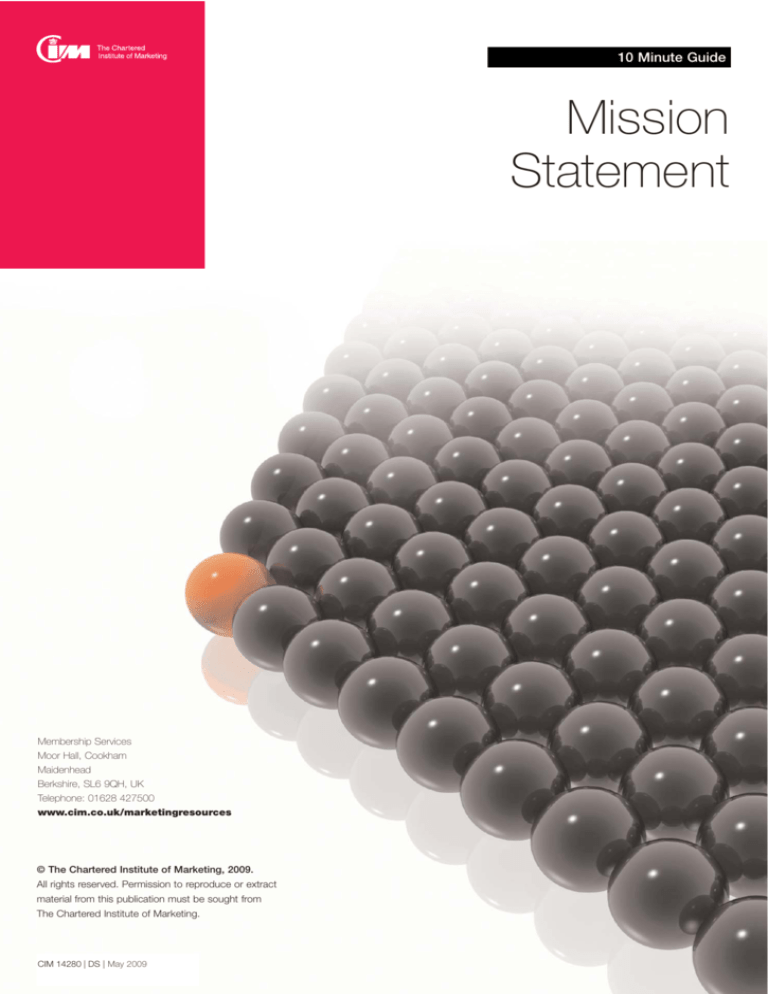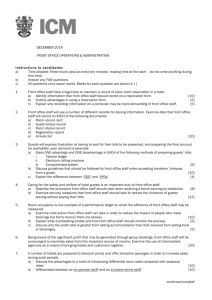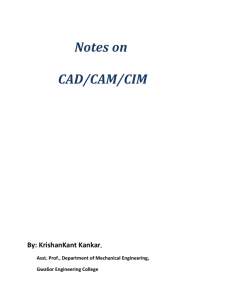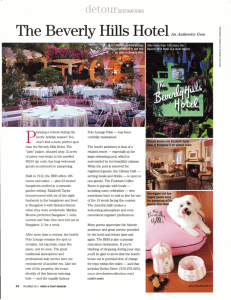
10 Minute Guide
Mission
Statement
Membership Services
Moor Hall, Cookham
Maidenhead
Berkshire, SL6 9QH, UK
Telephone: 01628 427500
www.cim.co.uk/marketingresources
© The Chartered Institute of Marketing, 2009.
All rights reserved. Permission to reproduce or extract
material from this publication must be sought from
The Chartered Institute of Marketing.
CIM 14280 | DS | May 2009
10 Minute Guide: Mission statement
Mission
Statement
Introduction
Why it is important
This item describes how to develop a
mission or vision statement for a business.
It explains why this is important and the
process you can use. By working your way
through the initial thinking process and then
the creative process, you will develop a
mission statement that communicates to
your customers and motivates your
employees.
An old saying has it that if you don.t know
where you are going, it doesn.t matter
which road you take. A mission or vision
statement acts as a clear signpost to the
future and provides a valuable focus to all
those who are interested in the business .
customers, employees, financiers, owners
and even suppliers.
What it is
A mission or vision statement is a
statement that provides a signpost of where
your business aims to be in the future.
Your mission or vision statement has to do
two things:
• It should explain to customers and other
stakeholders what business you are in
• It should be motivational and provide a
shared sense of purpose. This helps to
create a focus for the efforts of all your
employees and managers
Once you know where you are going as a
business, you can start to define relevant
strategies. This significantly improves your
chances of success as a business. Your
managers and employees will be more
effective in interpreting the respective roles
of other people in the business and they are
more likely to cooperate.
Mission or vision statements have become
common in large organisations, although
some are not as effective as they might be.
They can also help the smaller businesses
by providing a direction for its growth and
development plans. Here is an example of a
mission statement which has not changed
since the company, Newport News
Shipbuilding, was founded in 1886:
‘We shall build good ships here – at a profit
if we can – at a loss if we must – but
always good ships’. (Quoted in Drummond,
G and Ensor, J., (1999). Strategic
Marketing: Planning & Control. Oxford:
Butterworth-Heinemann)
CIM 14280 | DS | May 2009 | 2
10 Minute Guide: Mission statement
What you need to know
A mission statement is not the same as an
objective.
Mission statement
Objective
Benefit
Business has only one
Business may have many,
usually as .stepping stones.
consistent with the mission
Not usually quantified
Usually quantified, eg to
increase market share to 5%
Time not specified or
is only loosely defined
Specific time limit
Directional rather than specific
Is achievable and measurable
What makes a successful mission
statement? A good statement should:
• Provide future direction
• Be realistic, and therefore believable by
both customers and employees
• Be outward looking and contain a clear
customer benefit
• Be motivational, by embodying the
challenge and rewards
What you need to do
The creation of a mission statement comes
as the start of the process of defining where
your business is going and how you are
going to get there. To create a mission
statement, you need to answer four
questions:
• What business are you in?
• What are your business aspirations?
• What key words describe how the
product or service will be delivered?
• What is the best way to express our
mission?
1. What business are you in?
The first step is to be clear about what
business you are in. This may seem
obvious but is actually one of the most
difficult questions that you are likely to
encounter. For example, is an hotel in the
business of:
• Providing food and accommodation?
• Providing holidays?
• Providing leisure breaks?
• Providing facilities for training events?
• Enhancing personal well-being?
Many firms initially define their business in
terms of the products or services that they
provide, for example a butcher (seller of
meat), a baker (produces bread) or a
candlestick maker (makes candlesticks).
However, in defining the business domain in
which you operate, it is better to focus
upon the customer.s need that you are
fulfilling. This will ensure you remain
focussed because* You are in business to
solve a specific customer problem by
meeting a need.
* The ways in which that problem or need
can be fulfilled could change over time. If
you do not recognise these changes, your
customers will be attracted to the other
alternatives.
The table below shows the differences
between product/service and customer
based definitions.
Business
Type of business
Product/service offered
Type of business
Example of customer need met
Garden centre
Sells plants & accessories
Sells beautiful gardens
Courier
Sells transportation
Meets delivery requirements
Drill manufacturer
Makes drills
Sells the means to make holes
Tourist
information centre
Provides tourist information
Sells a hassle free visit to local
leisure and entertainment facilities
CIM 14280 | DS | May 2009 | 3
10 Minute Guide: Mission statement
When you are defining what customer
needs you are meeting, it is important not
to be too narrow or too broad in your
definition. If you are too narrow, you may
reduce the size or shape of the playing field
on which you will compete in the future.
Equally, if you are too broad, you may suffer
from lack of clarity. Your definition must take
on board the business. ability (resources
and skill) required to deliver and compete in
meeting these needs.
Continuing with the example of an hotel,
the mission statement could be:
‘We will provide all our guests with high
quality accommodation, superb food and
excellent service’
This explains what the owners want to
deliver. But what does it say about the
customer benefits the hotel is providing for?
‘Quality accommodation, superb food and
excellent services’ are all what the hotel is
providing rather than the customer benefit.
So, this version of the mission statement
could be improved by defining it in terms of
one or more customer benefits.
2. What are your business aspirations?
You can define your aspirations for the
business:
• In financial terms – for example, ‘the
business will double profits every five
years’
• In market terms for example, ‘the
business will become the market
leader’
However, neither of these is really
customer-driven or motivational. They are
less likely to motivate employees or fill them
with a collective sense of purpose. It is
better for these aspirations to be written in
terms of the customer groups you will
serve, the needs that you will address, or
the method by which you will achieve this.
Using the hotel as an example again, we
could say that the services on offer are
geared specifically towards guests looking
for a relaxing break:
‘We will provide such a relaxing stay that
our guests will want to return’.
This defines the customer benefit
(relaxation) and, by implication, the target
customer group. It would distinguish the
hotel from another that is targeting, say,
guests looking for a family holiday or a fully
equipped venue for a business activity
weekend.
3. What key words describe how the
product or service will be delivered?
The words you use in your mission
statement should relate to the customer in
a language they would recognise,
understand and value. In the example
above, we have used the words ‘relaxing’
(recognisable as a benefit) and ‘guests’
(rather than customers or clients).
In developing your mission statement,
consider how such words will add vitality
and meaning to your vision of the future.
4. What is the best way to express your
mission?
Now you are ready to create a number of
possible mission statements using the
thoughts you have gathered in answering
the previous three questions. Here is an
approach designed to get you underway if
you are not sure where to start.
• Start off with the words
• We are in the business of ..
• Describe the type(s) of customers or
customer group(s) you will serve
• Describe the customer need you are
satisfying or the customer benefit you
are providing
• Describe what you are doing or
providing to meet that need
CIM 14280 | DS | May 2009 | 4
10 Minute Guide: Mission statement
For example,
‘We are in the business of re-energising
(benefit to the customer) tired and stressed
people (customer group) by providing a
relaxing stay in a peaceful location with
healthy food and exercise (what you are
providing)..
It can be seen that, in this example, the
final statement meets all the criteria. This
does not mean that this is the best, or
indeed the only, mission statement. In fact,
it is worth working up a number of
statements that all meet the criteria.
The result contains the essential ingredients
but is a little clumsy so you may want to
polish it.
Then you can evaluate all the statements
you come up with using the following
criteria, rejecting all that do not pass the
test.
• It provides a view of the future
• It is credible to both customers and
employees
• It is outward-looking and contains or
implies a clear customer benefit
• It is unique to your business, embracing
what you are good at
This is a useful point at which to involve
your employees in the process. They will be
key in making the vision a reality and should
feel that they wish to contribute to it. They
should all be encouraged to evaluate the
statements as a whole, as well as the key
words or phases they feel provide the most
realistic and dynamic signpost to the future.
From this discussion a clear mission
statement should emerge - one that
motivates and involves everyone in the
organisation.
The table below illustrates how a number of
mission statements for our hotel are
evaluated against these criteria:
Mission Statement
Future
Credible
Outward
Unique
We will provide all our guests
with high quality accommodation,
superb food and excellent service
x
?
x
x
We will be the preferred choice in
Hightown for guests looking for high
quality accommodation, superb
food and excellent service
x
D
x
x
We are in the business of reenergising
tired and stressed people by providing
a relaxing stay in a peaceful location
with healthy food and exercise
x
D
D
D
We will re-energise tired and stressed
people by providing a relaxing stay in a
peaceful location with healthy food
and exercise
D
D
D
D
CIM 14280 | DS | May 2009 | 5
10 Minute Guide: Mission statement
What to do now
When you have come up with a statement
you are happy with, take it to the world.
Every time you mention it to customers and
others, you are not just reminding yourself
of what your business is all about but also
reinforcing your commitment to make it
happen. Here are some simple tips to
remember:
• It should be communicated consistently
to everyone within the business and
reinforced by action,not just words, at
every opportunity
• You should do nothing that will
compromise it. To do that would be to
dilute the business. purpose. And
without clear purpose, the direction of
the business becomes less certain and
the effectiveness with which it
progresses will be retarded
• You should measure how well the
business is performing to the values
and in the direction stated in the
mission. You should communicate this
at regular intervals
You have now laid the foundation of a
marketing plan or strategy. You can now
move on to set objectives (specific steps on
the way to realising your aspirations) and
define your marketing activities.
Where to find out more
For more information on deciding what your
marketing activities need to be to realise
your aspirations, take a look at the 10minute Marketing Mix.
For more information on how to use your
mission statement to promote your
business, take a look at 10-minute
Promotional Mix.
If you want to proceed with marketing
planning, there is a Marketing Planning tool
available and this can be found in the
marketing resources area at
www.cim.co.uk/marketingresources.
Finding out more
Visit
www.cim.co.uk/marketingresources
gives more useful advice for small
businesses wanting to build on their
marketing knowledge.
CIM 14280 | DS | May 2009 | 6





